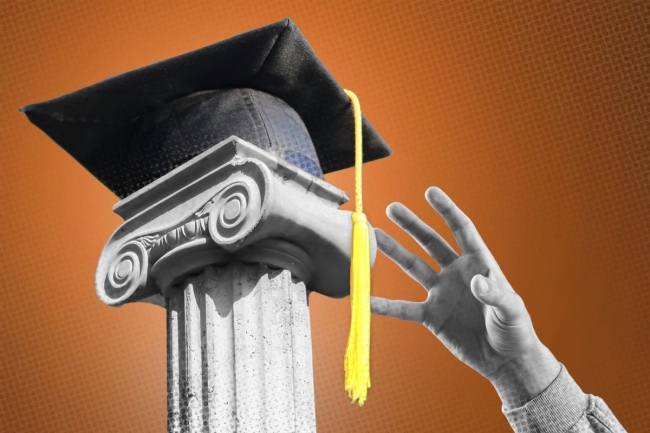You have /5 articles left.
Sign up for a free account or log in.

The population of students with some college but no degree grew by 2.9 percent last year, according to a new report.
Photo illustration by Justin Morrison/Inside Higher Ed | rawpixel | Anand Raj/Pexels
About 2.3 million students stopped out of college between January 2021 and July 2022, a 2.9 percent increase from the year prior, according to a report out today from the National Student Clearinghouse (NSC) Research Center. That number builds on a 1.4 million increase from 2020–21, bringing the total cohort of adults with some college education but no credential to 36.8 million.
For the first time, the NSC did not include adults over 65 in this year’s data in order to align more closely with the workforce goals of states investing in re-enrollment programs. The 25–35, 25–45 and 45–64 age groups all had roughly the same share of the some college, no degree population: about 30 percent. The 20–24-year- old cohort made up 6 percent, but it takes three semesters of nonenrollment for NSC to consider a student “stopped-out.”
A plurality of stopped-out students are white (32 percent), while 18 percent are Hispanic and 14 percent Black. Historically they’ve been mostly men, but recent trends have led to broader gender parity: now 46 percent are men and 44 percent women.
White and Asian American female students are much more likely to return to college than Black and Hispanic men, according to the NSC research. The stop-out population grew in every state except for Alaska, where it remained level.
The report contained some positive news: the number of students re-enrolling in the 2022–23 academic year increased by about 78,000, nearly reversing the prior year’s 80,000 student decline in re-entry.
NSC research director Doug Shapiro said that even though the re-enrollment numbers aren’t enough to offset the vastly higher rates of stop-outs, he was heartened by the reversal of the post-pandemic trend of falling re-entry numbers.
“The steady growth of this population is a persistent artifact of American higher education,” he said. “Higher ed produces more students who are leaving each year than returning … that represents an ongoing challenge as well as an opportunity.”
More states are jumping at that opportunity. A number of programs facilitating re-enrollment have cropped up in recent years, from Massachusetts’s MassReconnect, which addresses affordability concerns, to New Jersey’s ReUp program, which focuses on outreach and marketing. Some have been remarkably successful, like California Reconnect, which boosted re-enrollment rates in the state to 8.4 percent last year, far above the national average. Many of those initiatives were started after the COVID-19 pandemic devastated college enrollments, particularly at two-year institutions.
Su Jin Jez, CEO of the nonprofit higher ed and workforce policy organization California Competes, said the enrollment potential of some college, no degree students remains largely untapped; there are 6 million such students in her home state alone. But interest from colleges and state agencies is growing fast as workforce shortages and enrollment crises compound post-pandemic, she said.
“Higher ed wasn’t designed to re-enroll, and for so long institutions could comfortably rely on new students to fill in attrition,” she said. “The enrollment pressures of today have made institutions think more broadly about who a student could be … all of a sudden there was this attention to students that are leaving and should still be here.”
More Than Recruitment
Jez said that even as interest in some college, no degree students grows, many institutions are taking the wrong tack in trying to attract them.
“Peoples’ gut instinct for solving this problem is the same as usual: marketing and recruitment. ‘Oh well if they only knew about it, they’d come back!’” Jez said. “They’re not thinking about what’s actually happening that led a student to leave in the first place. Otherwise, you’re recruiting them back into an institution that didn’t work for them.”
That’s why stopped-out students who do entertain re-entry tend to go somewhere other than their former institution. The NSC report found that 63 percent of re-enrollees attend a new college, and 25 percent of those enroll in an entirely different sector, largely from four-year to two-year or private to public.
“This means that colleges need to do more than simply look to their own former students to identify candidates to re-enroll,” Shapiro said.
Jez said that’s a difficult prospect since data and student-profile sharing between institutions is very uncommon.
“Students leave an institution for many reasons, but they don’t often come back to a place where they felt they couldn’t succeed,” she said. “It’s hard because higher ed’s culture is competition, so you have to have someone really thinking about the students to see the benefits in this even though it could on the surface look like giving up an advantage.”
Many stopped-out students who return to college re-enroll in new fields as well, especially if they were studying something difficult, like STEM. They’re also more likely to re-enroll in an online degree program if they had been in-person before.
“Re-enrollees are trying to get their credentials as quickly as they can,” Shapiro said. “They want to recoup their investment as fast as possible, and not pay too much to do so.”
But many logistical and systemic barriers remain to re-enrollment, such as unpaid fees or academic probations that were never rescinded. In 2022–23, 25 percent of re-enrolled students who earned a credential or degree in their first year back did so without ever taking another course, meaning they only had some financial or administrative hurdle to clear.
“This is an inefficiency in the system, showing that colleges and universities can do a better job facilitating degrees that have essentially been earned but where other barriers got in the way,” Shapiro said.
New Experiments in Re-Enrollment
In Ohio, eight institutions entered into an experimental consortium in 2022 called the Ohio Comeback Compact to try to address many of the barriers to re-enrollment. They offer a wide range of regional colleges for stopped-out students, making it easy to transfer credits over to a new institution, as well as debt relief for those who qualify. Two years after it was established, students who participated were 50 percent more likely to re-enroll than their peers.
“Credit transfer is historically difficult,” said Pooja Patel, a senior analyst at Ithaka S+R who has been studying the consortium’s outcomes. “This program is unique because it gives students options.”
She added that the debt forgiveness incentive boosted the program’s success and presented new tuition revenue from stopped-out students. But the initiative still attracted only a small portion of the 9,000 students who meet the Compact’s eligibility requirements, suggesting plenty of room for growth.
“It’s not a silver bullet, but just knowing there was a jump start was enough to motivate [the students],” Patel said. “It can be hard, but we hope the program is a way to convince colleges that debt forgiveness can pay off … when institutions collect on debt payments, they’re usually getting pennies on the dollar.”
Jez said many institutions aren’t even aware of all the obstacles to re-enrollment they may have created, in the form of unnecessarily arduous administrative procedures or recruitment language that doesn’t include nontraditional students. When California State University, Dominguez Hills conducted a review of its re-entry process, it found an archaic system that included dozens of steps and a handful of preliminary fees. They’ve since streamlined and gotten rid of the costs.
Jez said these simple steps by institutions, as well as structured collaboration and cooperation between regional-serving two- and four-year institutions, could go a long way toward getting stopped-out students back in the classroom. Higher education leaders just need to be paying attention.
“This is a crisis, and higher ed needs to respond much more dramatically to it—for the students’ benefit, but for colleges, too,” Jez said. “I don’t think we’ve quite gotten there yet. But it’s starting.”









